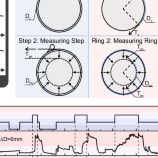
Articles
-
Oct 4, 2024 |
nature.com | Yuyang Zhang |Xiansheng Zhang |Yu Chang |Tingrui Pan |Ruojiang Wang |Xu Wu | +3 more
Erectile dysfunction (ED) is a prevalent type of sexual dysfunction, and continuous monitoring of penile tumescence and rigidity during spontaneous nocturnal erections is crucial for its diagnosis and classification. However, the current clinical standard device, limited by its active mechanical load, is bulky and nonwearable and strongly interferes with erections, which compromises both monitoring reliability and patient compliance. Here, we report a wearable adaptive rigidity monitoring (WARM) system that employs a measurement principle without active loads, allowing for the assessment of penile tumescence and rigidity through a specifically designed elastic dual-ring sensor. The dual-ring sensor, comprising two strain-sensing rings with distinct elastic moduli, provides high resolution (0.1%), robust mechanical and electrical stability (sustaining over 1000 cycles), and strong interference resistance. An integrated flexible printed circuit (FPC) collects and processes sensing signals, which are then transmitted to the host computer via Bluetooth for ED assessment. Additionally, we validated the WARM system against the clinical standard device using both a penile model and healthy volunteers, achieving high consistency. Furthermore, the system facilitates the continuous evaluation of penile erections during nocturnal tumescence tests with concurrent sleep monitoring, demonstrating its ability to minimize interference with nocturnal erections. In conclusion, the WARM system offers a fully integrated, wearable solution for continuous, precise, and patient-friendly measurement of penile tumescence and rigidity, potentially providing more reliable and accessible outcomes than existing technologies.
-
Jul 27, 2024 |
nature.com | Chenhui Guo |Jiantao Huang |Lei Chen |Yu Chang |Tingrui Pan |Kang Li | +5 more
Continuous hemodynamic monitoring in a wearable means can play a crucial role in managing hypertension and preventing catastrophic cardiovascular events. In this study, we have described the fully wearable tonometric device, referred to as flexible adaptive sensing tonometry (FAST), which is capable of continuous and accurate monitoring of hemodynamic parameters within the medical-grade precision. In particular, the FAST system integrates a 1 × 8 unit array of highly sensitive and highly flexible iontronic sensing (FITS) with 1 mm spatial resolution and a closed-loop motion system. The flexible tonometric architecture has been used to determine the radial arterial position with high sensitivity and high conformability, which simplifies the biaxial searching process of the traditional applanation tonometry into a highly efficient uniaxial applanation while keeping the medical-precision assessments. Importantly, a self-calibration algorithm can be automatically implemented during the applanation process, from which the intra-arterial blood pressure wave can be continuously predicted within the medical-grade precision, and subsequently, multi-parametric hemodynamic analysis can be performed in real-time. Experimental validations on health volunteers have demonstrated that the FAST measurements are all within the required accuracy of the clinical standards for continuous pulse wave assessments, blood pressure monitoring as well as other key hemodynamic parameter evaluations. Therefore, the FAST system, by integrating the flexible iontronic sensing array, provides a real-time, medical-grade hemodynamic monitoring solution in a continuously wearable manner, from which remote patient-centered monitoring can be delivered with both medical precision and convenience.
Try JournoFinder For Free
Search and contact over 1M+ journalist profiles, browse 100M+ articles, and unlock powerful PR tools.
Start Your 7-Day Free Trial →